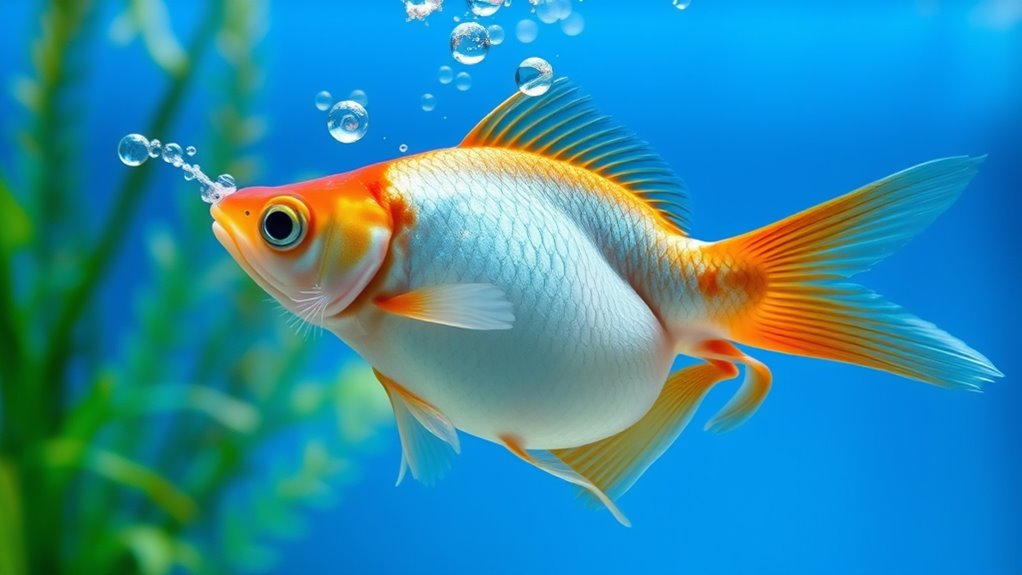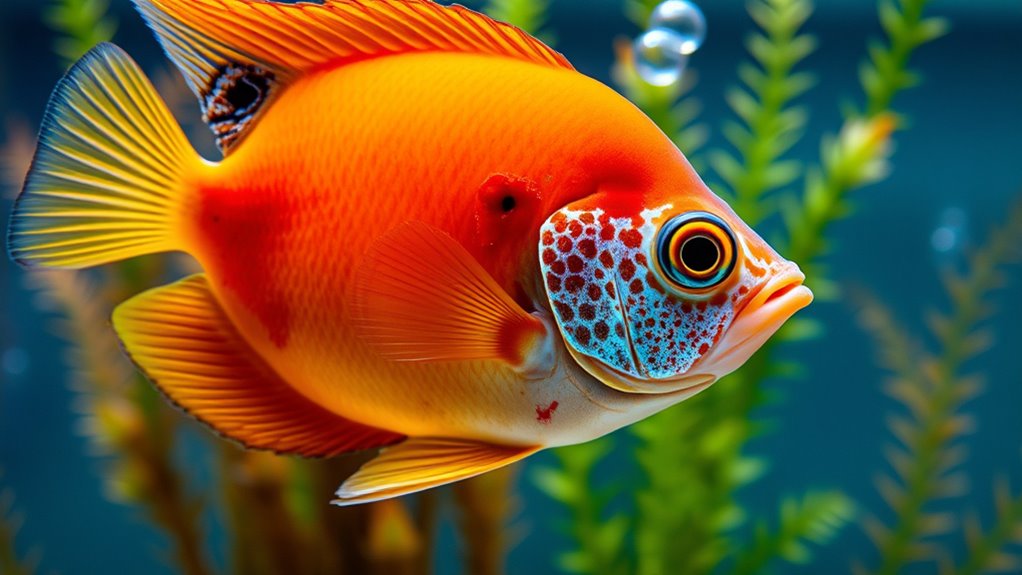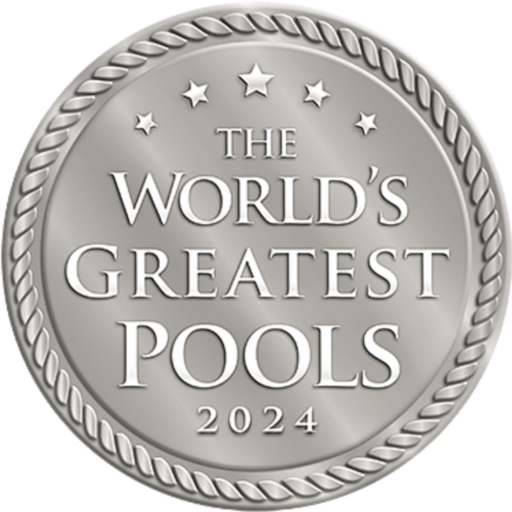Your fish’s sideways swimming likely indicates swim bladder disease, which affects buoyancy regulation. Common causes include overfeeding, poor water quality, infections, or physical injury. Check for accompanying symptoms like gasping, lethargy, or listing to one side. Immediate interventions should include fasting your fish for 24-48 hours, testing water parameters, and increasing aeration. The underlying cause will determine the appropriate treatment approach and recovery timeline for your aquatic companion.
Understanding Swim Bladder Disease: The Most Common Culprit

When examining a fish swimming sideways, swim bladder disease often presents as the primary etiology. This condition affects the gas-filled organ responsible for buoyancy regulation, disrupting hydrostatic equilibrium within the aquatic organism.
The swim bladder anatomy consists of a membranous sac that normally allows fish to maintain neutral buoyancy at differing depths. Dysfunction occurs when inflammation, infection, or physical compression impairs normal function. You’ll observe clinical manifestations including: listing to one side, inverted swimming, or inability to maintain horizontal positioning.
Diagnostic indicators include abnormal swimming patterns, distended abdomen, and buoyancy irregularities. Causative factors may include bacterial infections, dietary issues (particularly overfeeding), constipation, or congenital defects. Environmental parameters, including temperature fluctuations and poor water quality, can exacerbate symptoms by compromising swim bladder integrity.
Dietary Causes: Overfeeding and Poor Nutrition
Overfeeding your fish can cause intestinal distension that compresses the swim bladder, resulting in buoyancy dysregulation manifested as lateral swimming patterns. Nutritional deficiencies, particularly in B vitamins and fat-soluble vitamins A, D, and E, can compromise neurological function and swim bladder membrane integrity. High-quality commercial feeds with appropriate protein-to-fat ratios are essential for preventing metabolic disorders that affect buoyancy control mechanisms in captive fish species.
Bloated Swim Bladder Issues
Although many swim bladder disorders stem from congenital defects, dietary factors frequently precipitate acute dysfunction in otherwise healthy fish. Your fish’s buoyancy control system relies on proper swim bladder function, which becomes compromised when excessive food consumption causes gastrointestinal distension. This mechanical compression impedes normal swim bladder operation.
| Severity | Clinical Signs | Treatment Protocol |
|---|---|---|
| Mild | Intermittent listing | 24-hour fast, reduced feeding |
| Moderate | Persistent sideways swimming | 48-hour fast, pea supplementation |
| Severe | Inverted positioning, respiratory distress | Veterinary consultation, potential aspiration |
The pathophysiology of swim bladder malfunction typically involves compression from adjacent organs. You’ll notice your fish struggling with equilibrium maintenance as pressure increases. Implementing fasting periods allows gastrointestinal decompression, often resolving buoyancy abnormalities within 72 hours. For recurrent cases, evaluate feeding frequency, food type, and environmental parameters.
Vitamin Deficiency Effects
Beyond mechanical swim bladder compression, nutritional imbalances greatly affect fish homeostasis and buoyancy control. Deficiencies in B-complex vitamins, particularly thiamine (B1) and pyridoxine (B6), impair neurological function governing equilibrium. When your fish lacks these essential nutrients, vestibular disturbances manifest as lateral swimming patterns.
Vitamin C deficiency compromises collagen synthesis, affecting swim bladder membrane integrity and elasticity. Without adequate vitamin absorption, fish cannot maintain proper buoyancy regulation or neuromuscular coordination. Commercial feeds often contain insufficient nutrient sources, especially for species with specialized dietary requirements.
You’ll need to supplement with species-appropriate foods rich in essential micronutrients. Live foods (daphnia, bloodworms) provide bioavailable vitamins that pellets may lack. Consider soaking dry foods in vitamin solutions to improve nutritional density and restore proper swimming posture through targeted nutritional intervention.
Food Quality Matters
The quality and quantity of nutrition directly correlate with swim bladder function and lateral swimming presentations. Dietary insufficiencies precipitate abnormal swimming behavior through inflammation of the gastrointestinal tract, affecting buoyancy regulation.
Implement these nutritional interventions to mitigate lateral swimming syndrome:
- Establish consistent feeding schedule – Provide 2-3 small meals daily rather than single large feedings to prevent gastric distention
- Ensure food variety – Rotate between high-quality flakes, pellets, and live foods to deliver complete nutritional spectrum
- Pre-soak dry foods – Hydration prevents air ingestion which exacerbates swim bladder dysfunction
- Fast affected specimens 24-48 hours – Permits gastrointestinal clearance and reduction of pressure on swim bladder
Diagnostic indicators of nutritional etiology include concurrent abdominal distention, fecal inconsistencies, and symptom amelioration following dietary modification.
Water Quality Issues That Affect Swimming Patterns
Water quality parameters directly impact your fish’s neurological function and swimming abilities, with ammonia and nitrite toxicity often causing erratic swimming patterns and loss of equilibrium. pH level imbalances disrupt osmoregulation, leading to stress responses that manifest as tilting or sideways swimming as fish struggle to maintain their position. Oxygen deprivation, resulting from insufficient aeration or overcrowding, damages gill function and impairs buoyancy control, compelling fish to swim at abnormal angles to optimize oxygen uptake.
Ammonia and Nitrite Toxicity
Poor water quality, specifically heightened ammonia and nitrite levels, represents one of the most common physiological stressors causing abnormal swimming patterns in fish. These nitrogenous compounds accumulate from metabolic waste, uneaten food, and decomposing organic matter, creating toxic conditions that compromise neurological function.
Ammonia sources include fish excretion and protein decomposition, while nitrite effects manifest through methemoglobinemia or “brown blood disease.” You’ll observe these clinical manifestations:
- Initial erratic swimming followed by lateral positioning (sideways orientation)
- Compromised equilibrium due to vestibular system inflammation
- Respiratory distress with increased opercular movement
- Neurological impairment affecting swim bladder function
Testing water parameters immediately when observing sideways swimming is essential for differential diagnosis. NH₃ levels exceeding 0.02 ppm and NO₂ above 0.1 ppm require prompt intervention through water changes and detoxifying agents.
Ph Level Imbalances
Three distinct pH deviations acidosis, alkalosis, and rapid fluctuations can induce abnormal swimming postures including the characteristic lateral positioning observed in affected specimens. Acidosis (pH <6.5) disrupts gill function and osmoregulation, while alkalosis (pH >8.5) affects neurological function and induces stress responses. Both conditions compromise equilibrium organs, manifesting as erratic lateral swimming patterns.
Rapid pH fluctuations exceeding 0.3 units within 24 hours create physiological shock, regardless of absolute values. These oscillations destabilize the swim bladder’s gas exchange mechanism, resulting in buoyancy dysregulation. Implementation of regular pH testing using calibrated digital meters rather than colorimetric kits provides superior diagnostic accuracy. Treatment requires gradual correction through partial water changes (15-20% volume) using pre-conditioned water adjusted to approximate the target pH value of 7.0-7.5 for most freshwater species.
Oxygen Deprivation Problems
When dissolved oxygen (DO) levels decrease below 4mg/L, fish exhibit characteristic sideways swimming patterns as an adaptive response to hypoxic conditions. Your aquatic pets experience environmental stress when oxygen saturation falls, triggering compensatory behaviors to enhance gill exposure to available oxygen molecules.
Diagnostic indicators of hypoxia include:
- Surface gasping behavior with increased opercular movement
- Disoriented swimming patterns, including lateral positioning
- Reduced activity alternating with erratic movements
- Darkened gill tissue upon examination
These manifestations represent physiological distress as fish attempt to improve oxygen absorption efficiency. Low DO typically results from overcrowding, excessive organic waste decomposition, or inadequate water circulation. Immediate intervention requires increasing aeration, reducing bioload, and performing partial water changes to restore ideal dissolved oxygen concentrations (6-8mg/L) and normalize swimming behaviors.
Bacterial and Parasitic Infections Affecting Balance
Numerous bacterial and parasitic infections can severely compromise a fish’s vestibular system, resulting in the characteristic sideways swimming pattern observed in affected specimens. Common bacterial infections include Pseudomonas and Aeromonas species, which may infiltrate the swim bladder or inner ear structures, disrupting equilibrium maintenance.
You’ll need to monitor for accompanying symptoms like lethargy, inflammation, or skin lesions to differentiate between infection types. Parasitic infestations, particularly Ichthyophthirius multifiliis (ich) or Hexamita (affecting internal organs), can likewise impair neurological function when they migrate to cranial regions.
Diagnosis requires microscopic examination of gill biopsies, skin scrapings, or fecal samples. Treatment protocols typically involve broad-spectrum antibiotics for bacterial origins or antiparasitic compounds for invertebrate pathogens, coupled with water parameter optimization to facilitate recovery.
Physical Injury and Trauma: When Your Fish Needs Emergency Care

Physical trauma represents a distinct etiology for lateral swimming that requires immediate intervention. Mechanical disruption of the swim bladder or vestibular system can precipitate acute disequilibrium, manifesting as abnormal lateral orientation in aquatic specimens.
Evaluate your fish for these critical injury signs:
- Visible external trauma (lacerations, contusions, scale loss)
- Asymmetrical fin positioning or damaged fin rays
- Protrusion of internal organs or swim bladder herniation
- Erratic swimming patterns alternating with periods of immobility
Your emergency response should prioritize water quality stabilization and isolation in a hospital tank. Antibiotic prophylaxis may prevent secondary infections at trauma sites. Prognosis correlates with injury severity and promptness of intervention. Neurological damage affecting proprioceptive function often presents the greatest therapeutic challenge in trauma-induced lateral swimming.
Treatment Options and Recovery Strategies
Depending on the etiological basis of lateral swimming behavior, therapeutic intervention must follow a targeted, multifaceted approach. You’ll need to address the underlying pathophysiology while supporting homeostatic mechanisms during recovery. Treatment options vary considerably based on diagnostic findings.
| Etiology | Primary Intervention | Recovery Timeline |
|---|---|---|
| Swim Bladder Dysfunction | Antibiotic therapy, NPO 24-48h | 7-14 days with 80% efficacy |
| Vestibular Disorder | Environmental modification, reduced current | 3-5 weeks, variable prognosis |
| Toxin Exposure | Water parameter correction, activated carbon filtration | 48-72h following detoxification |
Monitor for clinical improvement by evaluating swimming patterns, nutritional intake, and respiratory rate. Recovery strategies should include quarantine protocols, gradual reintroduction to normal feeding schedules, and water quality maintenance. Recalcitrant cases may require specialized consultation with an aquatic veterinary specialist.
Frequently Asked Questions
Can Certain Fish Breeds Be More Prone to Swimming Sideways?
Yes, specific fish breeds exhibit genetic predispositions in the direction of swimming abnormalities. Your fancy goldfish varieties (telescopes, bubble eyes) demonstrate breeding tendencies that impact buoyancy control due to modified swim bladder anatomy. Betta fish with excessive fin development can’t maintain proper orientation. Livebearers with spinal deformities from selective breeding often display altered fish behavior. These morphological adaptations compromise hydrodynamic efficiency, affecting the vestibular system’s function and proprioceptive capabilities that regulate spatial orientation during locomotion.
Is Sideways Swimming Always a Sign of Illness?
No, sideways swimming isn’t always indicative of illness. While often associated with swim bladder dysfunction, this behavior can represent normal fish anatomy adaptations in certain species or temporary behavioral patterns. You’ll observe some fish naturally orient differently due to specialized body structures. When diagnosing abnormal swimming, consider duration, accompanying symptoms, and species-specific norms. Transient sideways positioning following feeding or during mating displays doesn’t necessarily warrant clinical intervention, though persistent lateral swimming typically requires thorough physiological assessment.
How Long Can a Fish Survive While Swimming Sideways?
The survival duration of a fish exhibiting lateral swimming dysfunction varies markedly based on the underlying etiology. You’ll observe that fish experiencing swim bladder disorders may persist for weeks to months with proper intervention, while those suffering from advanced bacterial infections might survive only 24-72 hours. Persistent fish stress during this abnormal swimming behavior accelerates physiological deterioration. Prompt diagnostic assessment and environmental parameter correction are critical determinants in extending survival timeframes during this symptomatic presentation.
Can Old Age Cause a Fish to Swim Sideways?
Yes, old maturity can cause your fish to swim sideways. As fish mature, they experience declining organ function, particularly affecting their swim bladder and vestibular system. These maturing effects commonly manifest as compromised buoyancy control and impaired equilibrium. You’ll notice alterations in fish behavior including listing, rolling, or swimming at abnormal angles. Senescence can deteriorate neurological function governing spatial orientation. Senior fish may also develop skeletal deformities or muscle atrophy that further compromises their swimming mechanics and proprioception abilities.
Should I Separate a Sideways-Swimming Fish From Tank Mates?
You should isolate a laterally swimming fish from tank mates promptly. This aberrant fish behavior can indicate infectious conditions that may compromise tank dynamics. Quarantine prevents pathogen transmission and reduces stress from potential aggression directed at the compromised specimen. Monitor water parameters in isolation while establishing differential diagnosis. Furthermore, separation allows for targeted treatment administration without exposing healthy specimens to unnecessary medications. Prognosis often improves with this clinical intervention strategy that addresses both individual welfare and population health.



